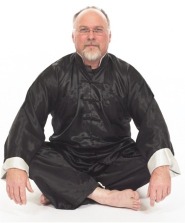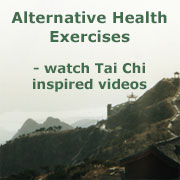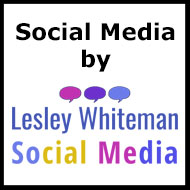A few thoughts for those of us doing personal practice in our gardens: –
Clear your mind and quieten your body
Relax your hips – sink slightly before you transfer weight and on the leg you transfer to
Allow your pelvis to sink under you when you move so it can stay beneath your upper body
Relax your trailing hip and leg
Relax your shoulders – allow them to move passively and softly at all times
Read good books on the subject and watch good practitioners on video.
I watched a Japanese TV program recently about slow squats as an exercise for lowering blood sugar and burning fat.
They say that a series of 10 sec squats in reps of 10 repeated 3 times per session then done in two sessions a week for three months can reduce blood sugar levels as a treatment for diabeties and leads to weight loss.
The explanation is that slow reps change fast twitch white muscle by increasing the number of mitochondria in the muscle – the muscle turns pink and burns much more energy.
See here https://www3.nhk.or.jp/nhkworld/en/special/episode/201903160810/
It’s a bit like Chi Kung exercises – I have been doing it for a couple of weeks and my legs and knees are feeling much better, and actually it is not too hard work.
Right or wrong, correct or not correct? When we begin right at the beginning as Tai Chi first timers there is a tendency to think there is right way to do things – and to expect our teacher to know what it is. After all isn’t that the way the rest of life works?
Then we may notice that we can’t do it the same way our teacher is doing – even when we think we are doing it like the teacher we are often corrected – and notice that other students are doing it differently again but do not get corrected. We may notice that many top level teachers demonstrate differently and make different corrections, so let us instead call them adjustments. If we persist we may begin to think that we are making progress – and you are, but possibly not in the way you think. It is difficult to let go of the idea that there is a right or correct way – while we focus on what goes where and how, it is unlikely that you have found it.
However do not be downhearted, you are simply learning about walking without understanding where you are going – but never fear you are on the right path ( there is after all only one, although with many diversions and false trails ) keep going and the path will be revealed – it is the natural path of being human in a human body and it is here that the concept of chi becomes useful.
It is probable that we each have within ourselves a model that we think is right, even if we suspect that it isn’t, but if we could just put right the faults then all would be well. That internal model is almost certainly wrong – or at least we regard it in a perspective that means it can never work properly until we change that perspective. So in private practice do not be afraid to experiment, even do things “wrong” – and observe carefully because you may find that in fact the “wrong” things are actually “right”. And of course the things you thought were right may be completely wrong.
One of the benefits I have found from lock down has been the opportunity to do my own daily practice during which I have been reminded of the saying from the Tai Chi classics that one’s Tai Chi should be “light and limber” – especially when watching videos of master Chen Yu who has a beautifully loose and light way of moving.
It reminded me in turn of my own teacher Karel Koskuba who talks about practicing to be “loose, agile, bounce and shake”.
All these word models of course are short forms of concepts that have deep emotional roots – they are shorthand for these more diffuse concepts – a form of sigil which we employ to help us move toward our goal – remembering that the exercises and forms are ways of learning how to do – but are not themselves what we are seeking – that is something altogether different.
This has been an excellent time to explore Tai Chi on a personal basis – to spend time on individual practice looking deeper into the exercises and the form, so I am delighted that many people have been following the exercises and the form on my Alternative Health Exercises website – if you haven’t found it yet then check it out here – it’s free and includes lots of short exercise sessions as well as a demo of the first 15 postures that you can follow along with.
I have also been working with a couple of senior students doing one to one video coaching, again for free – and would be pleased to do the same with other existing students at whatever level.
On the health front I recently watched a program on NHK World TV which was showing an exercise developed by a Japanese doctor. These repetitive slow squats done for 20 mins twice a week were shown to burn blood sugar and body fat – to the point that they were effective in controlling diabetes and aiding weight loss. These exercises are very similar to Tai Chi and Chi Kung.
We all know that a chain is only as strong as it’s weakest link, we probably know Archimedes idea that given a solid place to stand on and a lever long enough he could move the earth. But how do we connect these two ideas? Well let us think of the human body as a mechanism slightly more complex than a chain but nonetheless with weak links or in this case components, organic muscles, ligaments. tendons, bones and so on. A mechanism which operates as an intermediary between the ground and any other force which operates on it.
So our task as Tai Chi practitioners is to find the weak links and work to strengthen them, at the same time to adjust the way they work together ie their relationship in movement – like changing the gears on a car or adjusting the tyre presures, then to attend to the control system which enables us to balance all the forces – generally, but not always using the ground as our base.
However ours is not a rigid mechanical thing – our mechanism requires that to be most effective all the parts move to create space for other parts to move. We find that if part of the mechanism is too tense it locks up and then the rest does not work very well – so we look for compliance and ease of movement between the parts. In studying our body as a mechanism we should consider what it means to be a biological mechanism – we cannot for example simply remove a part and replace it with a better one, we cannot alter gearing by turning a screw, we cannot improve resilience by fitting rubber bushes. However the human body is remarkably plastic in he way it changes to accommodate greater weight, muscles and tendons likewise, they also adapt to the way we move so that we change our bodies by what we choose to do with them, our nervous system learns to operate differently as we learn a skill – whether Tai Chi, dance or sculpting.
So there is a lot to do when practicing alone. In a class we should be studying how our teacher manages to achieve this development so we can apply it to ourselves. When we work with others we should be learning how they do it and how we can use our skill.
No not an ancient technique taught to me by a monk in the ice and snow of Tibet – just a suggestion from my teacher Karel Koskuba that I am finding very rewarding. Simply practice the form as slowly and as smoothly as you can – it may surprise you what you notice.
Perhaps the balance you thought was OK now proves less so but you have time to adjust, maybe the timing of your arms and legs no longer feels right – but you can do something with your centre which makes a difference?
Glacial Tai Chi – it reminds me I heard recently that my old Karate teacher Hirokazu Kanazawa passed away last December – he was a great natural talent who was fast and smooth – he was the one who first introduced me to Tai Chi – and he used to say “how can you do it fast if you cannot do it slow.”
When looking at a master in life or on video it seems true to say that if you can see what is going on then you can – probably – do it (given a body that is actually capable) and only need practice to learn how to make it work. If on the other hand – you cannot see it then you probably cannot do it – unless you are doing it already and simply don’t realise it!
I find that shaking is an excellent way to loosen the body – quite vigorous to get the whole body loose and then soft and small shaking to relax the small muscles and gently open up the joints.
When doing our form this is also a useful technique – a bit like trying to fit a component into a tight spot – like a pin into a hole – we need to jiggle it a bit. When you can’t quite get a joint to move easily or if it seems to stick – try a small shake and see if a little jiggle helps to get things moving the right way.





